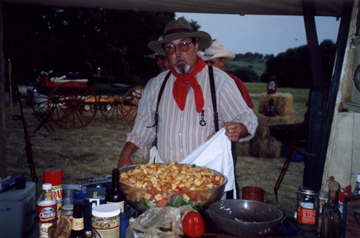 Ought-Zero cook Skillet Wiginton gets ready to serve up some ‘chuck’ on the prairie.
Ought-Zero cook Skillet Wiginton gets ready to serve up some ‘chuck’ on the prairie.
|
|
A D V E R T I S E M E N T
|
|
|
|
A D V E R T I S E M E N T
|
|
Big Wheels A-Turnin’
Chuck wagon cooking is becoming an ‘in’ thing to do for traditionalists and kitsch-lovers alike.
By DAN MCGRAW
One evening this past summer out in Big Sky country — otherwise known as Westover Hills — yokels dressed in fancy suits and cocktail dresses dined on prime rib, beans, fruit cobbler, and biscuits, along with some really strong coffee. The entire meal, which had been cooked over a good ol’ fashioned fire pit, was prepared and served by grizzled-lookin’ guys in cowboy hats and boots, leather vests, and denim. With enough booze in ya, you could squint your eyes and believe the year was 1882.
The wild, wild people catering this party were local professional food industry workers (from this time period, yes). Unlike their colleagues who work in buildings, these cooks and others who share a similar, powerful interest in Western heritage work on chuck wagons. Events like the party in Westover Hills are getting more popular across the country — here you can find dozens of catering companies doing chuck wagon food. As you can imagine, in a city whose nickname is “Cowtown,” the stuff is catching on.
Most of the chuck wagon parties are light-hearted affairs, like the one in Westover Hills. The majority of customers aren’t too concerned about authenticity. “What they want is the ambience, cooking outdoors, our staff in period costumes, and cowboy poets and music,” said Bo Powell, co-owner of Ought-Zero Land & Cattle, a throwback food service company that uses a chuck wagon built in 1892. “The food may not be strictly chuck wagon-style, but the atmosphere is closer to the original.”
Chuck wagon events aren’t cheap — prices can range from a paltry $20 a plate for basic burgers and beans to $200 a plate for beef tenderloin with all the trimmings. (Some chuck wagon workers will even hang around and cook breakfast.) A lot of the parties are thrown for out-of-town guests by wealthy Cowtowners who understandably think their non-countrified friends will enjoy the oddly educational kitsch.
From the end of the Civil War to the mid-1800s, chuck wagons served a vital purpose — to carry food for the pioneers or bring food to cowboys on the trails and loggers out in the pines. Chuck wagons’ usefulness was gradually reduced by advances in transportation, like the railroad and auto-voiture. By the early 19th century, the only time you’d see a chuck wagon was on a track in some sort of novelty race. Still, thanks to decades of Western movies and Rawhide re-runs, the image of a chuck wagon rolling on its big wheels beneath the stars is part of many Americans’ image of cowboy life. In fact, Texas is considering making the chuck wagon the “official state vehicle” (contrary to one state senator’s suggestion that the “low-rider” represent Texas).
There are chuck-wagon cooking competitions across the country, where authenticity in both preparing the food and the food itself is serious business. Powell said, “When we go to competitions, we do food that is as authentic as possible from the time period when chuck wagons were a staple of trail drives.”
When judges aren’t involved, though, chuck wagon cooks can be as carefree and creative as they want. A lot of them get a little gourmet. Terry Chandler, who owns Fred’s Texas Café and does some chuck wagon cooking on the side, might whip up a menu of venison loin in phyllo dough and goat cheese au gratin potatoes with Mexican and Asian seasonings. But the Outlaw Chef also insists on the basics: beans, biscuits, and strong coffee, all cooked over a fire pit. “Barbecue ain’t chuck wagon cooking,” said Chandler. “Real chuck wagon cooking is done by someone who can cook a creative meal on site, using only a wood fire and limited ingredients.”
The secret tool seems to be a cast-iron Dutch oven — it’s authentic but still allows chefs to take a semi-modern approach. With this all-purpose pot, Ought-Zero can make its signature Mexican-style chicken lasagna casserole, while Chandler can do his duck and venison stew with carrots, potatoes, and apples. “We can do things on site that a lot of catering companies need big ovens to do,” said Chuck Hester of 2-H Chuck Wagon in Fort Worth. “But we build the oven in the ground.”
On the one hand, a chuck wagon can be just a way to add a touch of historical flavor to a backyard party. But add some chutzpah over the fire pit, and all sorts of food combinations — from stews and beans to venison and duck and shrimp — can arise. The result in some cases can be not only better than most home-cooking but also as inventive as some of the best restaurant dining.
Tom Perini, owner of Perini Ranch Steakhouse in Buffalo Gap, near Abilene, and author of the book Texas Cowboy Cooking, said that a fulfilling chuck wagon experience for folks today is both a mix of style and substance, old and new. “The experience of having a meal served from a chuck wagon by cowboys, getting the smell of meat and pots of beans cooking, enhances that dining experience,” Perini said. “It’s not what was cooked in the 1800s, but the techniques and the style can be very close. It’s comfort food that has some history. That’s why it has become so popular.”
 Email this Article...
Email this Article...

